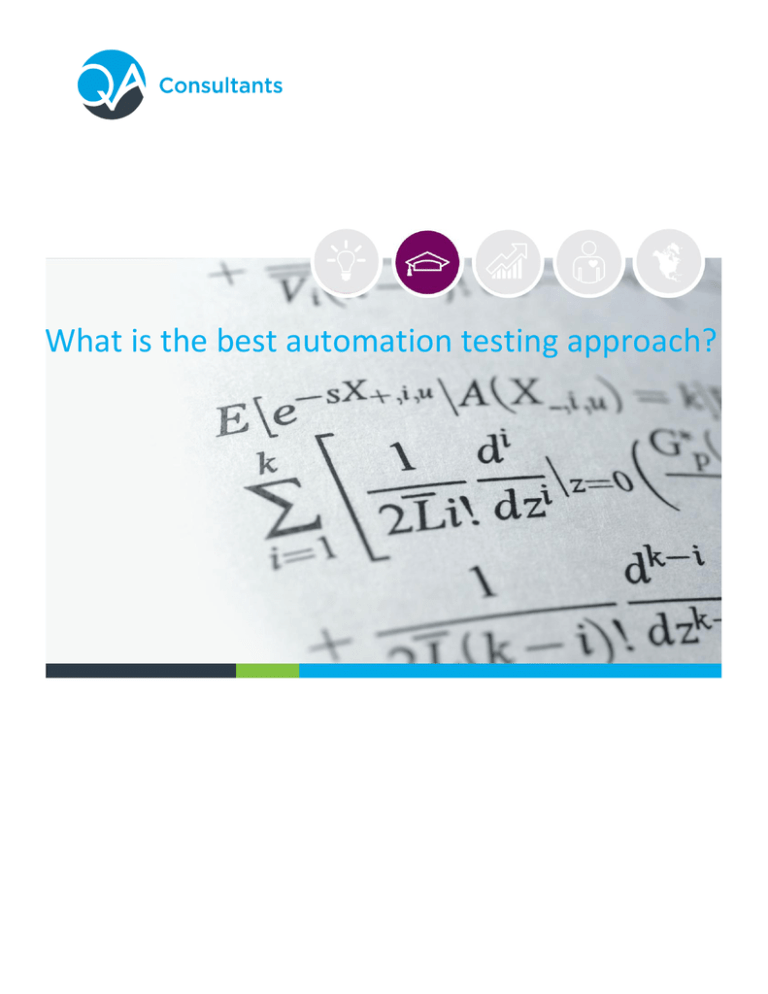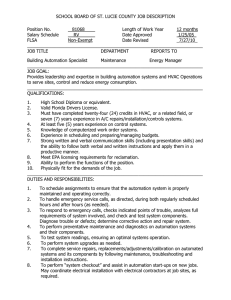
What is the best automation testing approach?
White Paper
What is the best automation testing approach
What is the best automation testing approach
1. Record & Playback
We are regularly called upon for advice on designing and deploying testing automation
tools and frameworks. Choosing the right automation approach is vital for ensuring proper
testing, minimizing development cost and delivering the lowest possible ongoing
maintenance expenses. This dialogue usually begins with a simple but important client
question: which automation approach works best? Based on our experience delivering
hundreds of automation projects, we can confidently answer: it depends.
Below is an overview of five different but industry-standard automation approaches to help
the client narrow down their options and support a more informed decision.
Summary
This is the most basic automation testing approach, with limited flexibility and long term utility.
Record & Playback functionality allows testers to interactively record user actions and replay them
back any number of times, comparing actual results to those expected. These techniques use only
hard-coded data; the utility is very dependent on the automation tool used. Record & Playback can
be used by non-coders if customization is kept at a minimum level and the verification points are
graphical.
Usage
Record & Playback is very useful for basic automation projects of short duration like automated data
entry or exploratory testing that feature re-record from scratch, have short test flows and
automated data entry.
Pros
Record & Playback is an ideal way to get into testing automation. This approach has a number of
advantages including low development cost, relatively simple design and ease of deployment.
Copyright © 2016 QA Consultants. All Rights Reserved.
www.qaconsultants.com
White Paper
What is the best automation testing approach
Cons
The basic nature of Record & Playback comes with a functional price. This technique has limited
performance (e.g., minimal test flow coverage), robustness (e.g., can break on build) and flexibility
.
Ongoing maintenance costs can be high especially when manual intervention is required.
2. Record & Playback Enhanced
Summary
This framework provides more functionality, supports parameterized data and enables
more use cases than the basic Record & Playback approach. However, its value is highly
dependent on the automation tool employed and the testing and programming skill of the
team. A good return on investment can be obtained within a single project.
Usage
Like standard Record & Playback, this approach is useful for testing projects with modest
automation requirements featuring: short term tests with short flow test cases and a
limited number of checkpoints and relatively stable environments.
Pros
Record & Playback Enhanced has some advantages including low cost development and
deployment (i.e. limited programing needed).
Cons
Like its cousin Record & Playback, this approach has a number of drawbacks including:
modest performance (e.g., limited test flow coverage); moderate usability and flexibility
with no multi-environment support; high maintenance costs due to manual intervention
(for analysis and validation) and the need to address checkpoints.
Copyright © 2016 QA Consultants. All Rights Reserved.
www.qaconsultants.com
White Paper
What is the best automation testing approach
3. Data-Driven Frameworks
Summary
Data-Driven techniques involve the creation of test scripts to run together with
their related data sets within a framework. The test environment settings and
controls are not hard-coded. A Data-Driven framework is ideal when the workflow
is repetitive but the data input is large – meaning different combinations of data
are required to successfully test the application. A skilled team is needed to
implement this approach.
Usage
This automation framework effectively satisfies more advanced testing needs like
testing single applications in multiple environments with big data sets, a limited
number of checkpoints and stable test cases. Batch run tests are possible with extra
development effort. Decent support is provided for distributed testing teams.
Pros
Data-Driven frameworks have a number of benefits including: very good usability
and re-usability of test scripts, solid test flow coverage
and reproducible test
results.
Cons
There are watch-outs in using these methods. Automation performance is based
largely on the automation skills of the person(s) undertaking the implementation.
These techniques also require regular maintenance (increasing costs) and manual
intervention upon failure.
Copyright © 2016 QA Consultants. All Rights Reserved.
www.qaconsultants.com
White Paper
What is the best automation testing approach
4. Keyword-Driven Frameworks, also known as table-driven or
action word testing
Summary
A Keyword-Driven framework is an advanced type of automated testing. Its
methodology divides the test development process into two distinct stages: a
design & development stage, and an execution stage. A Keyword-Driven approach
is ideal for many projects, environments and data sets. However, it also requires
sophisticated coding skills plus an up front investment in development time and
tools to maximize value. The design of the framework can play a major role in
determining the return on investment.
Usage
This testing method is suitable for many automation testing projects across
multiple applications, platforms and environments, featuring large data sets, short
& straight test cases
and a limited set of checkpoints. Keyword-Driven frameworks
are also ideal for batch run tests.
Pros
Keyword-Driven frameworks are a very good approach to leveraging automation. They have
many advantages including: very good script usability and re-usability
as well as test flow
coverage
and the ability to reproduce test results
. Moreover, test development does not
require sophisticated programming skills.
Cons
Higher performance does come with a cost including a significant upfront investment for
the design and implementation of the framework. Keyword limitations restrict the
complexity of test cases
. Employees will require knowledge of meta-languages
. These
Copyright © 2016 QA Consultants. All Rights Reserved.
www.qaconsultants.com
White Paper
What is the best automation testing approach
techniques also require regular maintenance (increasing costs) and manual intervention
upon failure.
5. Hybrid Keyword/Data-Driven Framework
Summary
Hybrid frameworks are the most sophisticated types of automated techniques available. For
example, they feature script-less test creation, the ability to import/export data from
various sources, a variety of checkpoints, and the power to integrate external objects. They
can generally accommodate grammar and spelling as well as information input. However,
the upfront investment, specialized skills prerequisite and ongoing maintenance costs can
limit its long term value and applicability for simple projects.
Usage
Hybrid Keyword/Data-Driven Frameworks are designed to satisfy an organization’s most
wide-ranging automation requirements covering multiple applications, platforms and
environments. They are suitable for testing situations with large and changeable data sets
and data transitioning cases. These frameworks typically provide strong support for
distributed testing teams.
Pros
Hybrid Keyword/Data-Driven Frameworks are among the most comprehensive and flexible
functional testing frameworks available. They feature high usability, re-usability and test
flow coverage and offer built-in consistency and severity validation.
Cons
There are some challenges with this approach including the need for a significant upfront
investment in development and skills for design and implementation. Ongoing maintenance
costs could also be noteworthy, potentially limited ROI. Finally, these frameworks may also
be overkill for many testing projects.
Copyright © 2016 QA Consultants. All Rights Reserved.
www.qaconsultants.com
White Paper
What is the best automation testing approach
The above analysis offers a general rule of thumb on which approach to use. What method
you ultimately choose will depend on your budget, timing, skills and environment as well as
your project’s testing goals. Fundamentally, test automation is a software development
activity; your team will need solid design and programming practices plus quality tools. A
low-risk way of getting into test automation is by building a smoke test that will quickly run
for each new build. This strategy allows you to learn automation as you go and to better
understand your organization’s capabilities. Finally, cost, complexity and technical
considerations will make many testing projects unsuitable for an automated testing
framework.
For further information please contact:
Harry France
Sr. VP Sales
(519) 575-0314
hfrance@qaconsultants.ca
Copyright © 2016 QA Consultants. All Rights Reserved.
www.qaconsultants.com






